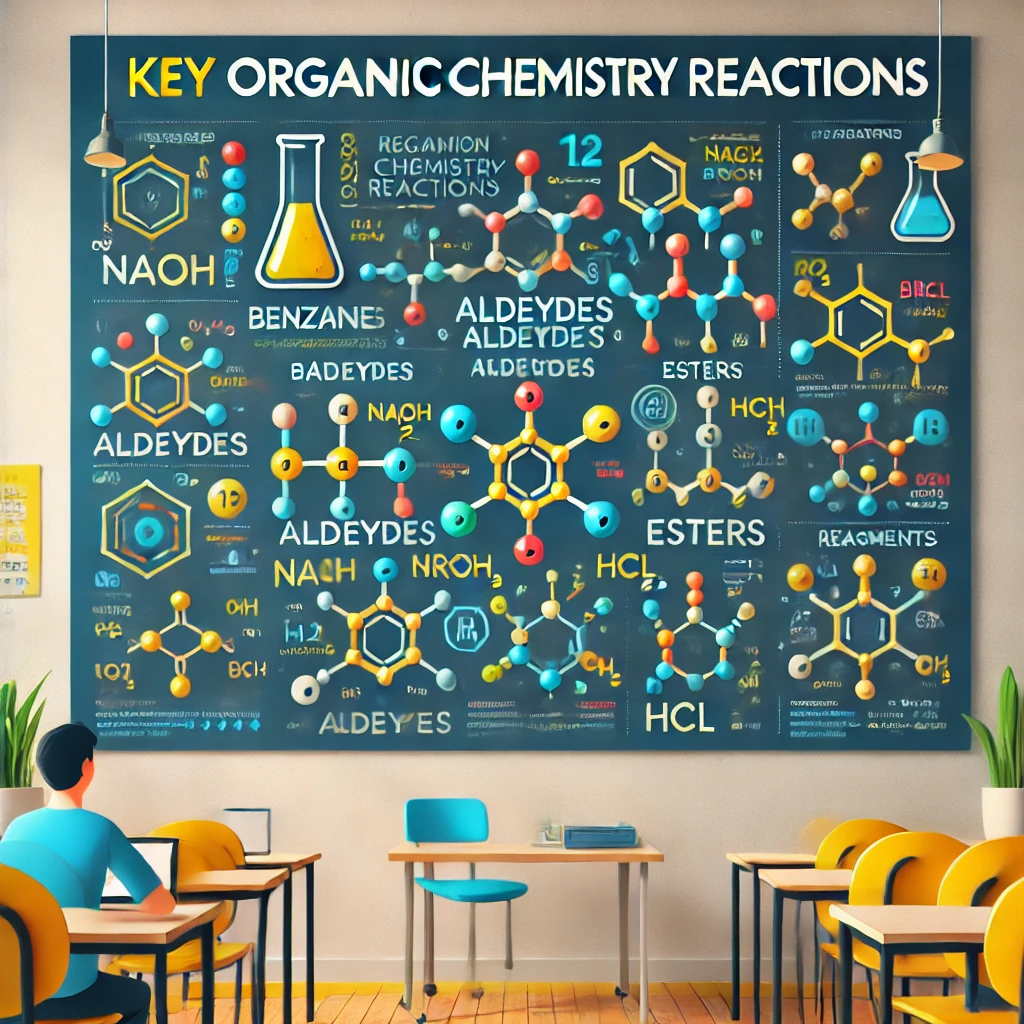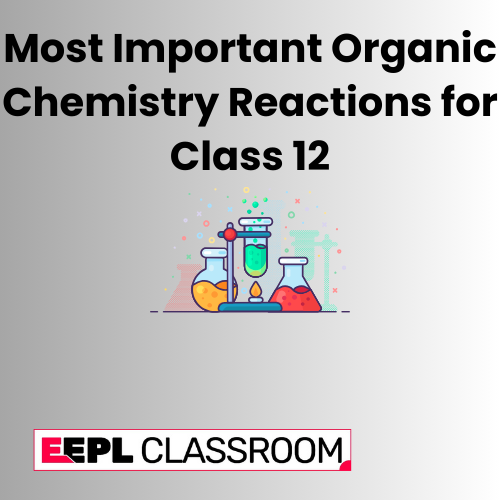Organic chemistry can feel tough, but mastering key reactions can make it easy. Here’s a list of important reactions that every Class 12 student must know, explained simply:
1. Aldol Condensation
- Happens in aldehydes and ketones with alpha-hydrogen.
- Two molecules join to form a beta-hydroxy aldehyde or ketone.
- Example: Acetaldehyde forms 3-Hydroxybutanal.
2. Cannizzaro Reaction
- Used for aldehydes without alpha-hydrogen.
- One molecule oxidizes, and the other reduces.
- Example: Formaldehyde forms methanol and formic acid.
3. Kolbe’s Reaction
- Turns phenol into salicylic acid.
- Involves CO₂ and NaOH.
- Example: Phenol + CO₂ → Salicylic Acid.
4. Williamson Ether Synthesis
- Makes ethers from alkyl halides and sodium alkoxide.
- Example: Ethanol + Sodium Methoxide → Ethoxyethane.
5. Friedel-Crafts Reaction
- Two types: Alkylation and Acylation.
- Adds alkyl or acyl groups to benzene.
- Example: Benzene + Acetyl Chloride → Acetophenone.
6. Hoffmann Bromamide Reaction
- Turns amides into amines.
- Needs Br₂ and NaOH.
- Example: Acetamide → Methylamine.
7. Gabriel Phthalimide Synthesis
- Prepares primary amines.
- Uses phthalimide and alkyl halide.
- Example: Phthalimide → Ethylamine.
8. Reimer-Tiemann Reaction
- Converts phenol to salicylaldehyde.
- Involves CHCl₃ and NaOH.
- Example: Phenol → Salicylaldehyde.
9. Haloform Reaction
- Produces haloforms (like chloroform).
- Involves compounds with CH₃CO group.
- Example: Acetone + Iodine → Iodoform.
10. Carbylamine Reaction
- Tests for primary amines.
- Involves CHCl₃ and alcoholic KOH.
- Example: Ethylamine → Ethyl Isocyanide.

11. Wurtz Reaction
- Combines two alkyl halides to form a higher alkane.
- Uses sodium in dry ether.
- Example: 2 CH₃Cl + 2 Na → C₂H₆ + 2 NaCl.
12. Finkelstein Reaction
- Replaces a halogen in alkyl halides with iodine.
- Uses NaI in acetone.
- Example: CH₃Cl + NaI → CH₃I + NaCl.
13. Sandmeyer Reaction
- Replaces the diazonium group in arenediazonium salts with halogens or cyanides.
- Uses CuCl, CuBr, or CuCN.
- Example: C₆H₅N₂⁺Cl⁻ + CuCl → C₆H₅Cl + N₂.
14. Gattermann Reaction
- Prepares aromatic aldehydes.
- Uses HCN and HCl in the presence of AlCl₃.
- Example: Benzene → Benzaldehyde.
15. Hell-Volhard-Zelinsky (HVZ) Reaction
- Brominates carboxylic acids at the alpha position.
- Requires red phosphorus and Br₂.
- Example: CH₃COOH → CH₂BrCOOH.
16. Rosenmund Reaction
- Reduces acyl chlorides to aldehydes.
- Uses H₂ with Pd/BaSO₄.
- Example: CH₃COCl → CH₃CHO.
17. Clemmensen Reduction
- Reduces carbonyl compounds to hydrocarbons.
- Uses Zn/Hg with HCl.
- Example: CH₃COCH₃ → CH₃CH₂CH₃.
18. Wolff-Kishner Reduction
- Reduces carbonyl compounds to alkanes.
- Uses hydrazine (NH₂NH₂) with KOH.
- Example: CH₃CHO → CH₃CH₃.
19. Perkin Reaction
- Forms alpha, beta-unsaturated aromatic aldehydes.
- Uses aromatic aldehyde and acetic anhydride.
- Example: Benzaldehyde → Cinnamaldehyde.
20. Stephen Reaction
- Converts nitriles to aldehydes.
- Uses SnCl₂ and HCl.
- Example: CH₃CN → CH₃CHO.
Tips to Remember
- Use mnemonics for groups and reagents.
- Practice equations regularly.
- Solve previous exam questions.
With these reactions in mind, scoring in organic chemistry becomes much easier!
Read Our Latest Blog
Common Mistakes to Avoid in Class 12 Math Exams
Phone Number: +91-7488456170
Email ID: abhishek@eepl.me
Our Platforms:
Digilearn Cloud
EEPL Test
Live Emancipation
Follow Us on Social Media:
Instagram – EEPL Classroom
Facebook – EEPL Classroom
Stay connected and keep learning with EEPL Classroom










